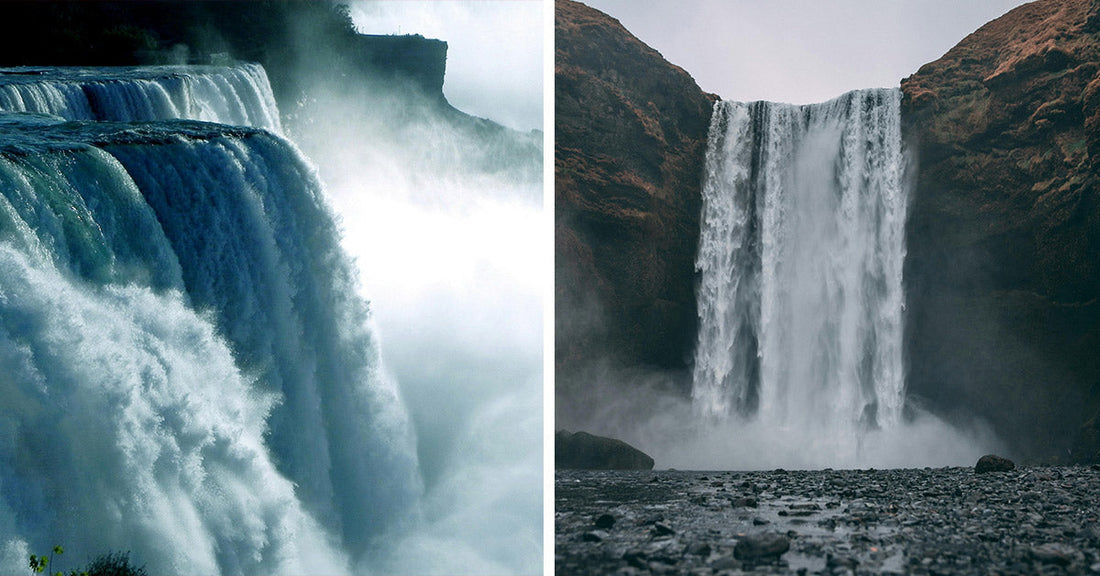This Hidden Arctic Waterfall Dwarfs Every Other Cascade on Earth
Matthew Russell
Ships cross the narrow gap between Iceland and Greenland every day. Crews feel only the gentle roll of the North Atlantic, unaware that miles beneath their keels the planet’s mightiest waterfall is in full plunge.
The Denmark Strait cataract descends about 11,500 feet in a single, uninterrupted sheet of icy water, dwarfing even Venezuela’s famed Angel Falls, EarthSky reports. No sunlight reaches the drop, no thunderous spray greets sightseers. Yet its silent torrent shapes weather systems, nourishes fisheries, and keeps Europe livable.

The Denmark Strait cataract plunges roughly 11,500 feet underwater.
Cold Meets Warm, Density Does the Rest
The spectacle begins where frigid Nordic Sea water spills south and collides with the slightly milder Irminger Sea. Colder water is denser, so it slides beneath its warmer sibling, much like cream slipping under skim milk. As that heavy sheet reaches an undersea ridge, it pitches over the edge and accelerates toward the abyss.
Oceanographers with the National Ocean Service calculate a flow of at least 123 million cubic feet every second—nearly 2,000 Niagara Falls at peak flood.
Wider Than a State, Steadier Than a River
While terrestrial cascades fall in ribbons only yards across, this submarine curtain extends roughly 300 miles from end to end, according to Earth.com. The cataract’s crest is more than twice the cruising altitude of a commercial jet below the surface, yet the entire wall of water moves as a single, coherent mass.
Instruments moored near the drop record current speeds topping three knots—fast enough to rearrange sediments on the seafloor.

That volume equals nearly 2,000 Niagara Falls at peak discharge.
Carved by Ice, Locked in Place
The ledge that triggers the plunge is a relic of the last Ice Age. Glaciers once scraped deep trenches across the seabed and left behind a hardened sill that acts as a hidden cliff. That geological legacy, outlined by Earth.com, now funnels cold Arctic water into the North Atlantic, pumping life-giving nutrients as it goes.
An Engine in Earth’s Climate Machine
Every drop that dives southward helps drive the lower limb of the Atlantic Meridional Overturning Circulation, a planetary conveyor belt that redistributes heat from the tropics toward the poles. The scale is staggering. Rough estimates from HowStuffWorks put the cataract’s discharge near 175 million cubic feet per second—enough water to refill Lake Superior in a little over a month. That flux clears space for the warm Gulf Stream to surge north, damping winter chills across Western Europe and feeding plankton blooms that anchor entire food webs.

Circulation from the underwater waterfall redistributes tropical heat toward northern latitudes.
Invisible but Not Ignored
Decades ago, researchers confirmed the cataract’s existence with salinity and temperature sensors. Today, fleets of autonomous gliders trace its pulse, searching for telltale shifts that might signal broader climate upheavals.
A slowdown could stall the North Atlantic’s heat pump; an acceleration might rearrange hurricane tracks. The stakes explain why marine scientists quoted by WhoWhatWhy compare the Arctic overflows to the heartbeats of Earth’s ocean circulation.
What Lies Ahead
Arctic warming is already tipping the balance between cold and warm layers. Fewer extreme winter winds in regions like the Gulf of Lion have weakened similar dense-water cascades, an early-warning pattern that researchers track closely, Earth.com reports.
Whether the Denmark Strait cataract will follow suit remains an open question. Future expeditions plan to map the plunge in three dimensions and install long-term moorings that can capture its rhythm through every season.

No direct video exists of the waterfall's descent.
The Hidden Giant’s Daily Work
For now, the torrent keeps humming beneath the waves, clearing a deep-sea highway that pulls nutrient-rich water to the surface in distant seas. Fishermen hauling cod off Iceland, commuters enjoying mild Januaries in London, and even coral larvae drifting on Atlantic currents all feel its influence—though most have never heard its name.
In a world fixated on visible extremes, Earth’s largest waterfall reminds us that the quiet forces often matter most.

